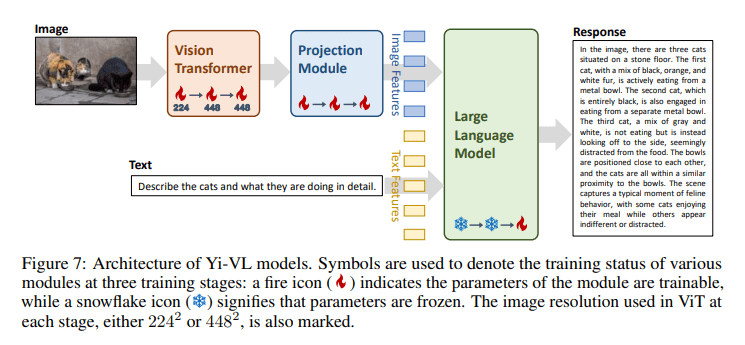- The Yi Model Family, developed by 01.AI, represents a significant advancement in AI technology.
- Unlike previous models, Yi integrates language processing and visual comprehension seamlessly, enhancing multimodal understanding.
- Built upon an evolved transformer architecture, Yi models prioritize data quality, resulting in superior performance across various benchmarks.
- The development process involves a layered approach, beginning with foundational language models and progressing to sophisticated chat models capable of handling extensive contextual information.
- The Yi-9 B model, developed through a novel two-stage training process, demonstrates substantial performance gains in coding-related tasks.
- The practicality of the Yi model series is highlighted by the balance between data quantity and quality, making it suitable for a wide range of applications.
- Notably, the Yi-34B model offers comparable performance to GPT-3.5 while being deployable on consumer-grade devices.
- Yi’s ability in vision-language tasks unlocks numerous possibilities for AI applications, from advanced chatbots to complex data analysis tools.
Main AI News:
The latest advancement in artificial intelligence is here: the Yi Model Family by 01.AI. This series of models represents a significant leap forward in the realm of language and multimodal capabilities, epitomizing the relentless pursuit to replicate and expand upon human cognitive functions through technological innovation.
Unlike its predecessors, the Yi model family integrates language processing and visual comprehension seamlessly, marking a groundbreaking achievement in multimodal understanding. This integration addresses the challenge of bridging the gap between human language and visual perception, necessitating inventive model architectures and refined training methodologies.
At its core, the Yi series comprises language-specific models adept at processing both textual and visual data. Built upon an evolved transformer architecture, these models have been meticulously fine-tuned with a focus on data quality, resulting in superior performance across various metrics. Moreover, the development process involved a layered approach, beginning with foundational language models and culminating in sophisticated chat models capable of handling extensive contextual information.
Central to the success of the Yi model family is its robust training methodology. The development of the Yi-9 B model, for instance, employed a novel two-stage process leveraging a vast dataset meticulously curated to enhance the model’s proficiency in coding-related tasks. Through constant learning rate adjustments and strategic batch size increments, significant performance enhancements were achieved across diverse domains, including reasoning, knowledge processing, coding, and mathematics.
However, the significance of the Yi model series extends beyond theoretical advancements; it represents a practical tool with myriad applications. Balancing data quantity and quality, coupled with strategic fine-tuning, ensures optimal performance across various tasks. Notably, the Yi-34B model stands out for its comparable performance to GPT-3.5, with the added benefit of deployability on consumer-grade devices, thanks to effective quantization techniques.
Of particular interest is the Yi series’ prowess in vision-language tasks. By integrating chat language models with vision transformer encoders, Yi demonstrates a remarkable ability to comprehend and respond to inputs comprising both images and text. This capability unlocks a plethora of opportunities for AI applications, ranging from advanced chatbots to sophisticated analytical tools capable of interpreting complex visual and textual datasets.
Conclusion:
The introduction of the Yi Model Family signifies a significant advancement in AI capabilities, particularly in language and multimodal understanding. This innovation has the potential to revolutionize various industries, offering more efficient and effective solutions for tasks ranging from natural language processing to computer vision. Companies in the AI market should take note of the Yi model series’ versatility and practicality, as it presents opportunities for groundbreaking applications and competitive advantages.

